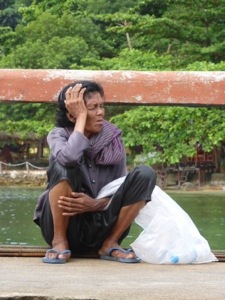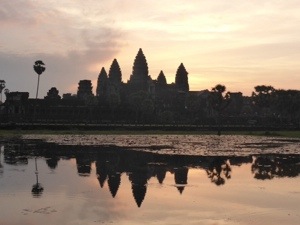I have recently left Cambodia, arriving in Bangkok by plane made the transition all the more stark. Having met people with such warmth and generosity of spirit and humanity, it has felt like I have made a very personal connection with the country and have enjoyed spending time there all the more for it. Travelling from the Cambodia border to Siem Reap by bus (there are no passenger trains in Cambodia, yet) the beautiful countryside continues seamlessly from Vietnam, with stretches of rice paddies a luscious green. From Ho Chi Minh City to the border, small stalls and shops of various kinds line the roadside. Once the border is crossed (and temperature taken by a man in a small wooden hut), the countryside opens out again and black water buffalo change to white oxen.
There is another currency and a new script, a new language and culture. Knowing little about the country, I did not have many expectations. I had, however, begun to read Luong Ung’s first book “First they killed my father”, and was quickly reminded of how recent and widespread the effects of the Khmer Rouge regime had, and continue, to be.
This time last week I had just returned from visiting S21, now kept as a museum, it was previously the prison in Phnom Penh. Before that, it had been a secondary school. One of many prisons which were created to hold and torture many thousands of people, S21 imprisoned and killed many of the most high profile prisoners from the city. Those who had worked for the government, teachers, doctors, artists, students, anyone deemed ‘intellectual’ or with professional training were deemed to pose potential threat to the Khmer Rouge in their bid to create a more ‘equal’, classless nation, and therefore were killed. The regime sought to anonomise everyone, issue clothes were black (colour was outlawed), everyone was set to work in the fields to grow rice and crops all year round. No one had any human rights, nothing could be said or done without prior approval of the regime.
The average age in Cambodia is now 23 years old. Fifty percent of the population is under 18. Over a third of the population was lost to this regime, either killed by soldiers or land-mines, or died of starvation. The population of Phnom Penh is still significantly smaller than it was before 1975 when the Khmer Rouge took power. There is not a family who was not affected, many are still looking for their relatives. Land mines are still killing people.
The guide who shows us around the prison, begins to talk of his story. He can have only been 3 or 4 years old when sent to a child labour camp. He told us how work was hard but accommodation “comfortable” in the dry season, this reversed in the wet season, as they lived and worked in the same place. Working in rice fields in the wet season meant they also slept in the wet. In the dry season they would be instructed to dig trenches, failure to meet the daily distance expected, resulted in further restriction of rations and physical punishment. He told us how he had been whipped for failing his task. Given inadequate and often reducing rations, their diet would be supplemented by what they could find, insects, rotten leaves and many things that should not be eaten.
When the regime was overcome 3 years 8 months and 21 days later, several women arrived to claim him as their son. He did not know who was telling the truth, too young to remember, his mother handed him a photograph of himself. He still did not know, he had never seen his own reflection. Putting trust in this woman he began to recognise the boy in the photograph as he studied himself in the mirror for the first time. Since then he has reconnected with surviving family members and worked hard, studied and learned English. Gradually gaining better paid employment, he spent time living in a temple before he was able to afford accommodation in the city, so that he can now work as a guide and ensure the story is not forgotten.
S21 has changed little since 1979, the cells prisoners were held captive in and tortured are much the same as they were 34 years ago. It housed 20,000 prisoners during it’s operation. There were 7 survivors. At least 20 other similar prisons operated throughout Cambodia. Chained together, prisoners had to ask the guard’s permission to be able to move or change position on the floor. Any sound of the chains which was not authorised was severely punished. Implements and tools for torture were explained in great detail, men and women treated differently, strategies used tailored to each gender. Unborn babies were treated with as much disregard as their parents, no one escaped the barbaric conditions.
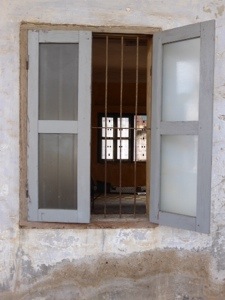
S21 prison, Phnom Penh (Louise Kenward) 2013
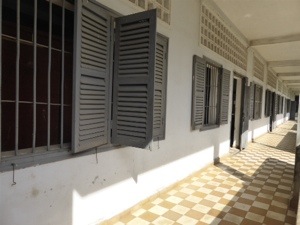
S21, Phnom Penh (Louise Kenward, 2013)
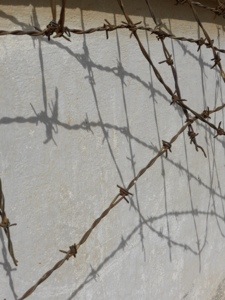
S21 prison, Phnom Penh (Louise Kenward, 2013)

S21, Phnom Penh (Louise Kenward, 2013)
Barbed wire was put up enclosing the galleries and windows several stories up, ensuring no one could get an easy escape through suicide. As we move through the museum there are several rooms of images, paintings and drawings by survivors of the regime, and photographs from the surviving film rolls, after much was destroyed by fire as the guards fled. Photographs of prisoners, each with a number on a tag hanging around their neck, each with varying degrees of despair and vacancy in their eyes, as they are regimentally recorded and documented by prison guards before they met their fate. There are many hundreds of faces staring out from the walls. Most of the meticulous documentation of prisoners and their deaths was destroyed. I wonder who had the task of processing the films as the emergent portraits were revealed, and how many more photographs were taken and never seen. As we emerge from the claustrophobic spaces into the courtyard outside and the warmth of the sun, relieved to be at the end of the tour and attempting to process what has been seen and heard, our guide gestures to a small table where an old man sits. One of the last of the surviving prisoners from S21, attending daily to share his story. The back of my eyes prickle at the closeness of all that I have just witnessed and my own helplessness.
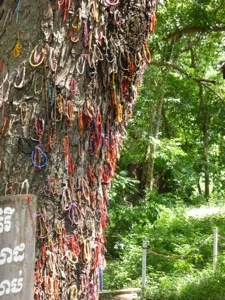
Chankiri Tree (killing tree), Killing Fields, Phnom Penh (Louise Kenward, 2013)
Great attention to detail went in to treating prisoners with as much torment, torture and humiliation as seems possible. This continued in to the ‘killing fields’, the mass grave for the prison. Again, this is just one of many. Sited not far from the city, another memorial to the regime and all the people who lost their lives there, again, each in more gruesome and brutal ways. The less time to do their work, the more efficient the guards would be. If they weren’t in a hurry, the more time available for more creative and long winded scenes could be enacted. They don’t need to be repeated here, but I will never forget. Anticipating a more tranquil memorial to the atrocities, butterflies fill the air and peaceful countryside sounds resonate, but where there have recently been heavy rains we are cautioned to watch our step. With each new rainfall, more human remains emerge to the surface along walkways.
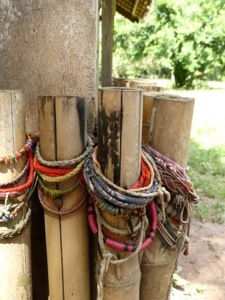
bamboo edging of mass grave for children, killing fields, Phnom Penh (Louise Kenward, 2013)



